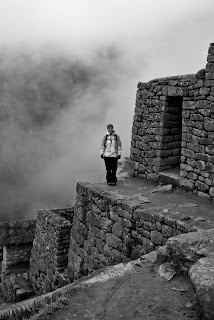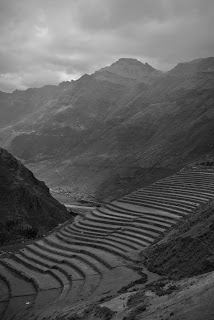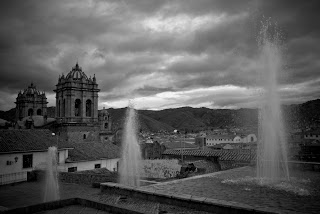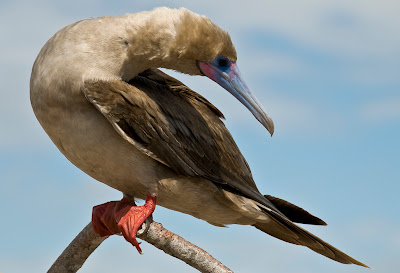 Five minutes of haggling by the dockside with the captain of the boat brought the price of our day trip to the islands of lake Titicaca down to a more reasonable 25 Soles ($8) per person. Having completed the negotiations the five crew members disappeared onto the quay only to return laden with fruit, vegetables,rice and an assortment of freeriding islanders toting their various handicafts. As the rain abated we made our way to the roof of the boat where we were finally able to see something of the lake.
Five minutes of haggling by the dockside with the captain of the boat brought the price of our day trip to the islands of lake Titicaca down to a more reasonable 25 Soles ($8) per person. Having completed the negotiations the five crew members disappeared onto the quay only to return laden with fruit, vegetables,rice and an assortment of freeriding islanders toting their various handicafts. As the rain abated we made our way to the roof of the boat where we were finally able to see something of the lake. Our first stop of the day was at the Islas de Ouros, an archipelago of floating islands. Each island plays host to an assortment of families that subsist from the lake and earn money from the passing tourist trade. Each island is made entirely from the reeds that grow on the lake. A floating base of reed roots are cut into squares about a metre across and then stitched together with twine. On top of this base they put down multiple layers of freshly cut reeds to bring the level of the island some 50cms or so above water level. On top of this they build huts out of the reeds as a shelter from the weather and reed boats to fish and travels round the other islands of the archipelago. The men spend most of their time fishing, hunting wildfowl and maintaining the island. The women and children make handicrafts to sell to the ever present stream of visitors from the mainland.
The whole visit to the islands was clearly a well choreographed routine. As we disembarked we were instantly assaulted by a stream of women and children pedaling their wares. Meanwhile, the men trotted of to fetch a board and some props for their demonstration in Spanish. A baby heron, used for night fishing like the cormorant fisherman of South China, squawked incessantly in the entrance to a nearby hut. After a fluent monologue about the island we were shepherded onto a waiting reed boat for a short trip to a nearby island. As we were about to leave, four young children jumped onto the boat and began working their way through their repartee of songs in French, English, Spanish and Quechua. Having exhausted their catalogue they arose with a chorus of One Sole and thrust forward their grubby little hands. You can’t blame the modern day islanders for taking advantage of an an opportunity to supplement their incomes but you do get the impression that this is fundamentally changing the culture of the islanders.
Our next stop on our tour of the Peruvian Islands of Titicaca was a small, but precipitous island called Tequille. This island, the home of our coca chewing crew is around four kilometres long and 500m wide. Rising steeply from the water, the island is terraced all over and plays host to 1800 people with a strong indigenous culture. All the men and women dress in traditional wool clothing: the men wearing black trousers, a voluminous white shirt, a woven cummerbund and a wee-willy-winky style hat; the women wear multiple layered skirts, a white shirt, a waistcoat and a black shawl that they use to cover their heads or carry goods on their back. Each man on the island wears either a fully red hat to denote that they are married, or a red hat with a white tail to denote that they are single. Each man is required to knit his own hat as a rite of passage. You often see them sitting on walls in the sun, intently focused on the task at hand, dexterously knitting their intricate patterns. The island itself looks much like what I would imagine a Mediterranean island to have been at the turn of the century. Small terraces take up every available piece of land to cultivate beans, potatoes and vegetables. Domestic livestock wander freely around the buildings and a small harbour is teeming with small fishing boats. As one walks up the steep steps to the village on top of the island one passes through ancient arches decorated with animal representations. Each archway frames a view across the shimmering lake back towards Puno on the mainland. As we made our way back to our base at Puno the skies began to threaten.
To the south, black clouds began to flash with lightening and the air on the lake took on a definite chill. The rainy season seems to have more relevance in this par of Peru and suggests that our time to come in Bolivia will be cold and wet, adding an additional challenge as transport becomes less reliable. However, today we head back to Arequipa for a planned visit to the Colca Canyon. We will be back in four or five days though, hopefully things will start to clear up or our journey through Bolivia will be the most challenging to date.








-12.jpg)
.jpg)
-4.jpg)


-35.jpg)
-7.jpg)
-10.jpg)
-24.jpg)
-16.jpg)
-4.jpg)
-9.jpg)
-5.jpg)
-8.jpg)